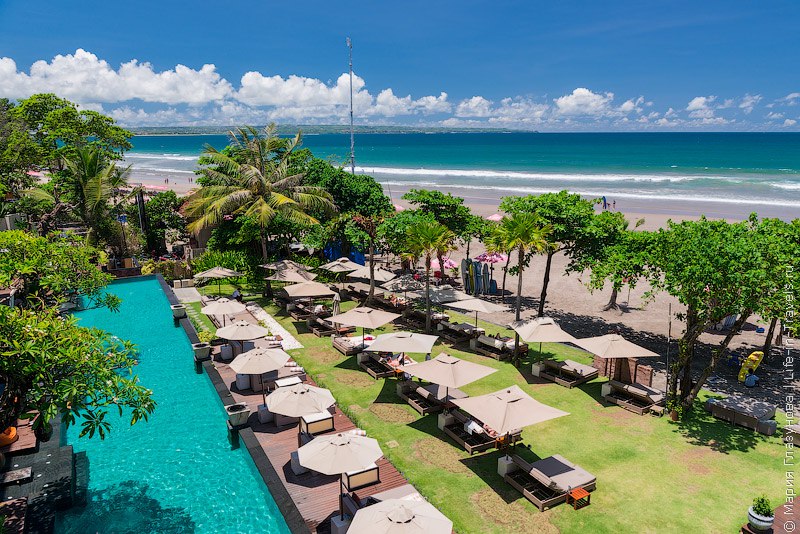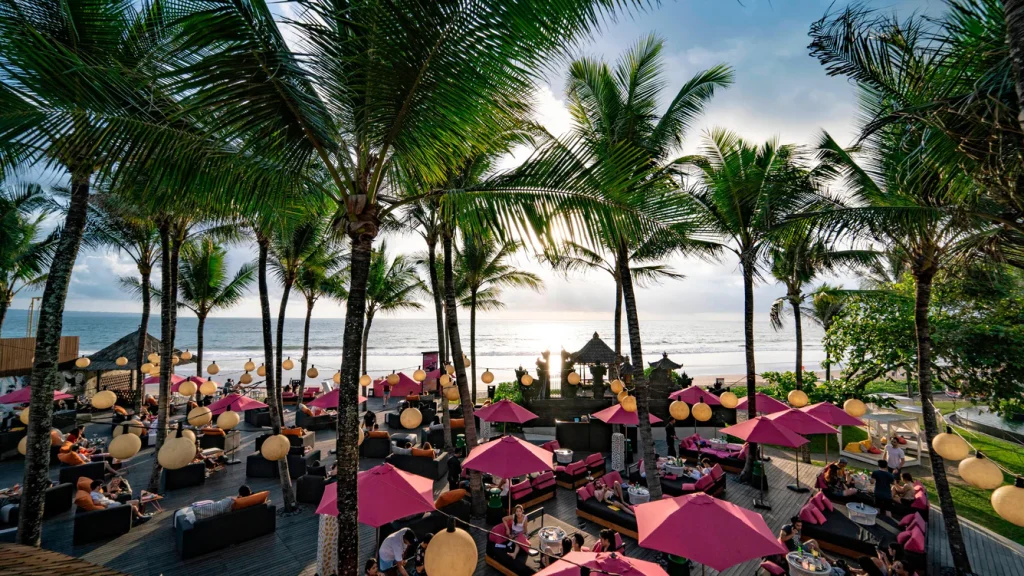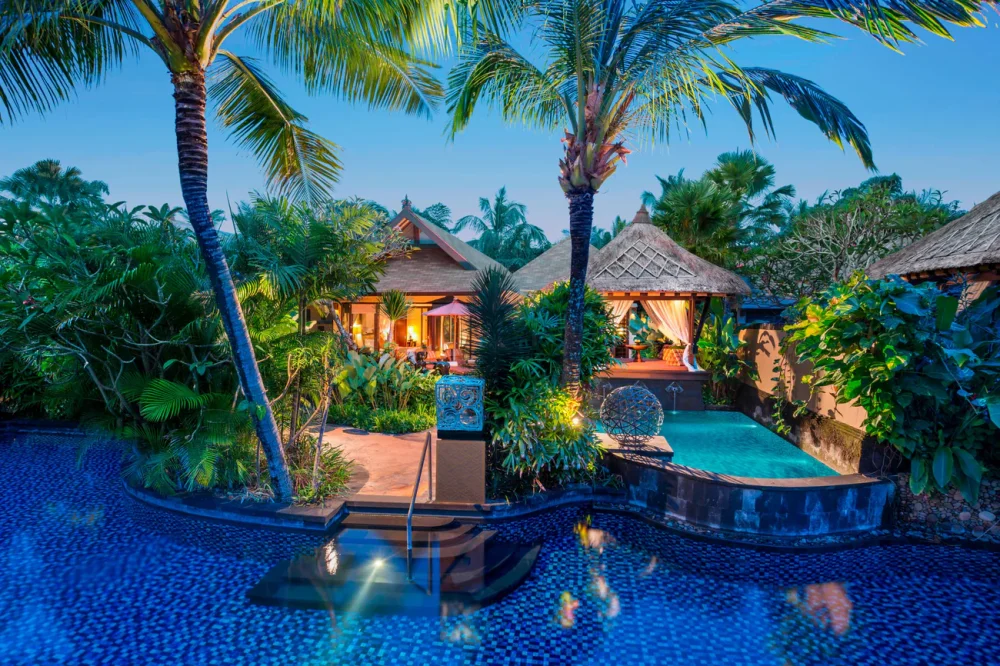Bali’s resorts have long since moved beyond the beach experience. Here, space does not just offer relaxation, but shapes the experience – bodily, visual, emotional. Each region of the island builds its own rhythm, creates a unique atmosphere and incorporates natural symbols into everyday life: the ocean, volcanoes, rice terraces, wind. The complexes are customised to suit your intentions: solitude, activity, yoga, digital reboot, gastronomy or noisy parties by the sea. In order not to make the wrong choice, it is important to understand not only the geography but also the philosophy of each destination.
Kuta is Bali’s premier resort
Kuta offers a classic beach vibe with an Asian flavour. The resort has built a reputation as Bali’s most bustling and youthful. The long coastline welcomes waves with speeds of up to 1.5 metres per second, creating ideal conditions for surfing. Dozens of nightclubs, cafes, souvenir markets and massage parlours line the streets. The principle of full accessibility works here: accommodation from $12 per day, bike hire at every turn, evening bars with live music in every neighbourhood. Destinations with such a density of events are rare, so Kuta becomes the choice of those looking for experience and socialising.
Clementine – comfort in the details
 Seminyak is shifting its focus from mass appeal to quality. The region offers signature hotels, designer boutiques, and concept bars. Gastronomy becomes part of the itinerary: each café builds a unique philosophy, from vegan sets to tasting Balinese coffee in five roasting formats. There are surf schools, yoga studios and sunset meditation areas on the beach. Bali’s Seminyak level resorts shape the aesthetic perception of the island – through footage, flavour, light, architecture.
Seminyak is shifting its focus from mass appeal to quality. The region offers signature hotels, designer boutiques, and concept bars. Gastronomy becomes part of the itinerary: each café builds a unique philosophy, from vegan sets to tasting Balinese coffee in five roasting formats. There are surf schools, yoga studios and sunset meditation areas on the beach. Bali’s Seminyak level resorts shape the aesthetic perception of the island – through footage, flavour, light, architecture.
Ubud – the territory of conscious holidaying
Ubud retreats from the ocean but increases contact with nature. The complex is surrounded by rice fields, hills, jungle and temples. The space builds an inner focus: meditation studios, breathing practice courses, art residences, herbal and natural spas. Toya Bunga Hot Springs, Kampuhan Jungle, Gunung Kawi Temple – not just locations, but places where the body ceases to be a machine. Bali resorts in Ubud don’t make noise – they lead. Hotels don’t just accommodate, they create an atmosphere. This is where the famous “yoga in the morning – rice paddies in the afternoon – fireworks show at sunset” distribution works.
Amed is a deep dive
Amed is a place for those who appreciate the underwater world. The long coastline hides shipwrecks, coral reefs, swarms of colourful fish and underwater tunnels. Visibility in the water is up to 30 metres. Bali resorts rarely offer such transparency and absence of waves. There are no clubs here. In return – silence, Creole fishermen, evening noise of cicadas. Hotels stand right on the slopes, and every breakfast is held with a view of the Agung volcano. In Amed, relaxation slows to a breathless pace.
Lovina is the delicate north coast
Lovina offers black volcanic beaches and swimming with dolphins. The region lends itself to a relaxed pace: yoga on the beach, day trips to Banyar hot springs, coconut oil spas and evening strolls along the seafront. Bali’s resorts in the north are still pristine. No one calls you to a bar or offers you a massage every 50 metres. Space speaks through sunsets and silence.

Medewi – surfing without spectators at one of Bali’s top resorts
Medewi is a rare point on the island’s map where there is still a sense of pristine beauty. Bali resorts in this area do not build glossy infrastructure, do not decorate reality. Wooden houses, mangroves, misty dawns and waves up to 200 metres long form a special rhythm. Surfing is practised here for the prepared. The waves stretch, break smoothly and allow you to build a long run. Instructors work individually. The infrastructure is minimal but functional: guesthouses, home-cooked food, surf schools and coconut oil spas. Medevi is not for photos, but for contact with yourself.
Nusa Dua – pollen purity and international comfort
Nusa Dua is a premium destination. It has cleaned beaches, controlled access and internationally recognised hotels. Bali resorts with this level of organisation are rare. Each hotel zone includes a private pool, ocean views, security and personalised service. For families, everything is here: kids’ clubs, activity programmes, babysitters, security. For business guests – business centres, premium restaurants, golf clubs. The main bonus is the calm sea. The lagoon is closed by a reef, the wave is almost absent, the sand is clean, without rubbish. Nusa Dua emphasises high service and predictable comfort. Stability, silence and respectability are appreciated here.
Uluwatu – cliffs, temples, infinity view
Uluwatu is known as the point of maximum contrast. Bali resorts in this area balance luxury cliffside villas with wild jungle trails. One of the island’s most spectacular roads passes through here – serpentines along the cliffs, with open views of the ocean. The waves are high and strong, perfect for professionals. The beaches are niche: Bingin, Padang Padang, Nyang Nyang. Accessing them takes effort, but every step becomes part of the journey.
There are cliff-top spas, haute cuisine restaurants, and yoga schools. A holiday here is not just a holiday, but an experience. Each villa is built into the landscape, the sunset is like a spectacle. Bali resorts in Uluwatu show how nature and architecture can speak the same language.
How to choose and make no mistakes
 Bali’s resorts are no longer a homogeneous mass of beaches and palm trees. Today, each corner of the island builds its own formula: one for tranquillity, another for waves, a third for revitalisation. The most important thing is not to look for a universal option, but to understand your own needs. Kuta with its parties and noise will suit some, while Amed with its quietness and underwater photography will suit others. A third will want wildlife in Medevi or polished luxury in Nusa Dua.
Bali’s resorts are no longer a homogeneous mass of beaches and palm trees. Today, each corner of the island builds its own formula: one for tranquillity, another for waves, a third for revitalisation. The most important thing is not to look for a universal option, but to understand your own needs. Kuta with its parties and noise will suit some, while Amed with its quietness and underwater photography will suit others. A third will want wildlife in Medevi or polished luxury in Nusa Dua.

 en
en  ar
ar  de
de  es
es  fr
fr  nl
nl  ru
ru  hi
hi  it
it  pt
pt  el
el 













